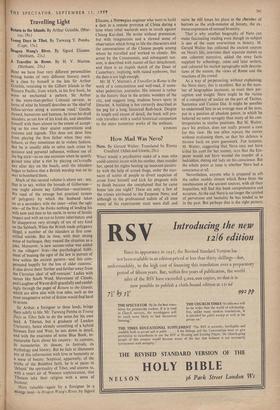Travelling Light
Dragon Wang's River. By Sigurd Eliassen. (Methuen, 21s.)
A Traveller in Rome. By H. V. Morton. (Methuen, 25s.) HERE we have four very different personalities Writing books of very different literary merit. In a class by himself is the late Sir Arthur Grimble, returning to the Gilbert Islands in the Western Pacific, from which, in his first book, he Wove so enchanted a pattern. Sir Arthur
is the more-than-perfect Colonial servant, in terms of what he himself describes as 'the ideal of fellow-service along a common road.' Gentle, Shrewd, humorous and humane, he loves his droll islanders, as too few of his kind do, and identifies himself with them almost to the extent of accept- ing as his own their quaint superstitions and customs and legends. This does not deter him from playing the firm father when they mis- behave, as they sometimes do in violent fashion. But he is usually able to solve such crises by patience and personal influence, without use of the big stick—as on one occasion when he quietly gained time after a riot by playing cat's-cradle day after day on the beach, until the islanders began to believe that a British warship was on its way to bombard them.
Much of this second volume is about sex : sex, that is to say, within the bounds of Gilbertese—
one might almost say Gilbertian—matrimony.
We read of the strange but practical system of polygamy by which the husband takes on as a secondary wife the sister—often the ugly one—of the first; he thinks nothing of lending his Wife now and then to his uncle, in terms of family respect and with an eye to future inheritance; and he disapproves very strongly of sex of any kind on the Sabbath. When the British made polygamy Illegal, a number of the islanders at first com- mitted suicide. But in time, with their strong sense of burlesque, they treated the situation as a Joke. Moreover, 'a new success-value was added to the villagers' lives—the psychological fulfil- ment of beating the ogre of the law in pursuit of love within the ancient pattern—and this com- Pensated happily for the loss of older customs.' It also drove them 'farther and farther away from the Christian ideal of self-restraint.' Ladies with names like South Wind, Movement of Clouds, and Laughter of Waves drift gracefully and confid-
ingly through the pages of Return to the Islands, Which are alive also with true tales, such as the most imaginative writer of fiction would find hard to invent.
Sir Arthur, a foreigner to these lands, brings them subtly to life. Mr. Tsewang Pemba in Young Days in Tibet fails to do the same.for his own
land. A Tibetan, but a graduate of London University, hence already something of a hybrid between East and West, he sets down in detail, and with the exactness of some Blue Book, in- numerable facts about his country : its customs, its monasteries, its dances, its festivals, its mythology and history. But he fails to illuminate any of this information with love or humanity or a sense of beauty. Sceptical, apparently, of the truths of the Buddhist faith, he is at pains to 'debunk' the spirituality of Tibet, and assures us, With a smart air of Western sophistication, that Tibetans take their religion with a sense of humour.
More valuable—again by a foreigner in a strange land—is Dragon Wang's River, by Sigurd
Eliassen, a Norwegian engineer who went to build a dam in a remote province of China during a time when rebel warlords were in revolt against Chiang Kai-shek. He writes without pretension, but with imagination and a shrewd sense of observation which bring to life the characters and the conversations of the Chinese people among whom he travelled and worked so closely. His arrest by the Communists, and subsequent ran- som, is described with matter-of-fact detachment, and there is an impish sketch of the Dean of Canterbury, implying, with raised eyebrows, that the dam is not high enough.
Mr. H. V. Morton's A Traveller in Rome is the work of a conscientious and well-read, if some- what pedestrian, journalist. His interest is rather in the history than in the artistic wonders of the city, and suggests long, studious hours spent in libraries. A building is but cursorily described as the peg for a long, historical flash-back. Despite its length and excess of detail, the book will pro- vide travellers with a useful historical companion to the more numerous works of the esthetes.
KINROSS


































 Previous page
Previous page